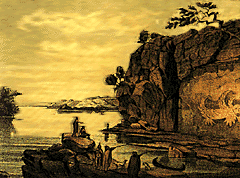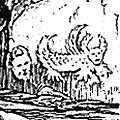




Editorial
|
Fragments
|
Cahokia I
|
Piasa Creature I
|
Sphinx II
Questions? Comments? Suggestions?
Contact us!
Register
for our Hall of Records Newsletter!
Questions? Comments? Suggestions? Advertising? Press Releases?
Contact us!
The Mysterious Piasa Creature Part I
|
Part II
|
The Fabulous Thunderbird
 n the spring of 1673, a small group of explorers left the Mission of St. Ignace in what is now northern
Michigan. this seven-member expedition set out from the Mission in two canoes and paddled west through
the chill waters of the Straits of Mackinac. The explorers left despite warnings from the Indians of
many dangers that lay ahead. Among those perils was a monster that devoured all who came near it.
n the spring of 1673, a small group of explorers left the Mission of St. Ignace in what is now northern
Michigan. this seven-member expedition set out from the Mission in two canoes and paddled west through
the chill waters of the Straits of Mackinac. The explorers left despite warnings from the Indians of
many dangers that lay ahead. Among those perils was a monster that devoured all who came near it.
The governor of the French colonies in Canada, Louis de Buade, had authorized the expedition to search
for a passage to the Pacific Ocean. And he had appointed a Canadian-born fur trader, Louis Joliet, and
a French missionary, Father Jacques Marquette, to lead the endeavor.
It was the 17th of May when the explorers set out from the Mission and began their voyage across the
upper end of Lake Michigan. They traveled westward some hundred miles and then turned southwest into
Green Bay. The expedition continued in a southwesterly direction, passed through a succession of
waterways in present-day Wisconsin, and reached the Mississippi River on the 17th of June. At that
point, the travelers turned south and followed the Mississippi downstream.
The explorers had expected to see new lands, people, and animals during their journey and, each day,
they realized one or more of those expectations. They could not, however, have anticipated the startling
phenomenon they encountered some 15 miles downstream from the confluence of the Mississippi and Illinois
Rivers. There, high on the limestone bluff above the east bank of the Mississippi, the travelers saw
hideous monsters painted in red, yellow, green, and black. A record of the trip kept by Father Marquette
described them:
They are as large as a calf, with head and horns like a deer or goat; their eyes red; beard like a
tiger's; and a face somewhat like a man's. Their bodies are covered with scales. Their tails are so
long that they pass over their heads and between their forelegs, under their belly, and ending like
a fish's tail.
The explorers paused to look at the strange pictures and, as they did, some may have remembered the
warnings from the Indians at the Mission of St. Ignace and wondered if the fierce creature that inspired
the pictures was about to appear. Fortunately, no monster appeared, and the travelers went on their
way. Some time later, however, it was learned that a creature similar to the paintings may have lived
in the area.
This creature, according to legend, was a large, flesh-eating animal. The Indians called it "Piasa"
pronounced (pie-a-saw), which meant "the bird that eats men." The Piasa Bird lived in a cave in the
bluff above the river. Whenever someone came too close to the bluff, it flew down and carried off its
victim. One day, an Indian chief named Quatonga prayed to the Great Manitou for help. In answer, he
was told that only his tribe could defeat the monster. Quatonga concealed 20 of his warriors near the
entrance to the Piasa Bird's cave. Then he stood in front of the opening to draw the creature from
its lair. The Piasa Bird saw Quatonga and swooped down upon him. However, before the monster could
reach the brave chief, his warriors killed it with poison arrows. The paintings on the bluff were then
made to commemorate the victory.

|
|
One of the oldest engravings showing the Piasa creature. From Henry Lewis,
Das Illustrierte Mississippithal, (Dusseldorf, 1854.) A closeup of the
creature can be seen above right.
|

|
|
A closeup of the Piasa creature. Note the difference between this representation and the
representations seen above.
|
A drawing of these paintings was made by a member of the expedition of 1673. However, the drawing
disappeared later and may have been lost when one of the canoes capsized. The oldest known picture
of the Piasa Bird appears in The Illustrated Mississippi Valley, Henry Lewis, Dusseldorf,
1854. This likeness depicts the paintings from a distance and, therefore, lacks detail. In addition,
it does not seem to exhibit the fierce characteristics mentioned in Father Marquette's description
and looks somewhat benign.
The original paintings on the bluff were destroyed during quarrying operations in the second half of
the 19th century. Perhaps the 1854 depiction was made after parts of the pictures were already gone
and, therefore, had to be reconstructed to some extent from the memories of those who had seen them
in their original forms. In 1934, the central figure in the paintings was restored on a bluff above
the Mississippi near the site of the original display. This representation of Piasa incorporated many
of the features described by Father Marquette.
Eventually, the 1934 restoration deteriorated and was replaced by an 8,500 lb. metal plate. This, in
turn, was removed in 1995. According to the Visitor's Center in Alton, Illinois, a new portrayal of
the Piasa Bird was made in 1998 on a bluff near the location of the previous one.
* * *
What did Father Marquette's written record of Piasa really represent? Was it the description of a real
monster, or of a fictitious animal created to frighten outsiders and keep them from moving into the
area? Unless someone uncovers new knowledge, these questions are also unlikely to remain unanswered.
History records that the expedition of 1873 did not find a passage to the Pacific. Even so, it did
discover the Piasa creature - a mystery that remains to this day. Find out more about the mysterious
Piasa Creature in Part II of the Piasa Creature series, to be published in the Summer 1999 edition of
Mysterious World.
* * *
Directions:
The current depiction of the Piasa creature can be reached via the Great River Road in southwest
Illinois and is a short distance northwest of the city of Alton. For more information, stop at the
Alton Visitors Center at 200 Piasa Street, Alton, Illinois 62002, or call 1-800-258-6645, or 1-618-
465-6676. MW
Links:
 The Legend of the Piasa Bird, hosted by Piasanet
The Legend of the Piasa Bird, hosted by Piasanet
The Mysterious Piasa Creature Part I
|
Part II
|
The Fabulous Thunderbird
Editorial
|
Fragments
|
Cahokia I
|
Piasa Creature I
|
Sphinx II
Questions? Comments? Suggestions?
Contact us!
Register
for our Hall of Records Newsletter!
Questions? Comments? Suggestions? Advertising? Press Releases?
Contact us!

Books:

 Lost Cities and Ancient Mysteries of North and Central America
Lost Cities and Ancient Mysteries of North and Central America
David Hatcher Childress
Rating:




One of the popular "Lost Cities" series, this book is a must-have guidebook for mysterious
places in North and Central America.
This book received several good reviews
Click
here
to buy this book.
 Historic Illinois From The Air
Historic Illinois From The Air
David Buisseret
Rating:




Review - Booknews, Inc., April 1, 1991:
Buisseret (history of cartography, Newberry Library) uses some 300 color and
b&w aerial photographs, satellite images, rare historic illustrations, and maps to
recreate the story of Illinois over centuries of growth and change. The great
cartography draws attention to the not-so-great (though fascinating and
instructive) aerial and ground photos.
Click
here
to buy this book.
 Michigan: Off the Beaten Path
Michigan: Off the Beaten Path
Jim Dufresne
One of the popular "Off the Beaten Path" series of travel guides.
Click
here
to buy this book.
The Jesuit Relations and Allied Documents : A Selection
(Carleton Library Science, 7)
S.R. Mealing, editor
Click
here
to buy this book.
Country Roads of Illinois
Marcia Schedler, Victoria Sheridan
Amazon.com price: (OS)
Ramble through America's rural heartland on winding back roads leading to
mom-and-pop markets, roadside fruit stands, steam railways, and an endless
variety of out-in-the-country attractions. Each title explores 10 or more
meandering weekend tours as authors share their intimate knowledge of people,
places, and country life.
Click
here
to buy this book.
 40 Great Rail-Trails in Michigan, Illinois and Indiana
40 Great Rail-Trails in Michigan, Illinois and Indiana
Roger Storm (Editor), Susan Wedzel (Contributor), Mike Ulm (Cor), Karen-Lee Ryan (Contributor)
Click
here
to buy this book.
Audio:

 Passion: Music for the Last Temptation of Christ
Passion: Music for the Last Temptation of Christ
Rating:





This CD received superb reviews (5 stars) and is personally recommended by the publisher.
(The background music on this page is from "In Doubt", the sixth track of this CD.)
Click
here
to buy this music.
Bibliography:

AAA Illinois/Indiana/Ohio Tour Book. Heathrow, Florida:
AAA Publishing, 1997.
AAA Michigan/Wisconsin Tour Book. Heathrow, Florida:
AAA Publishing, 1997.
Austin, H. Russell. The Wisconsin Story. Milwaukee, WI:
The Milwaukee Journal, 1948.
Balesi, Charles J. The Time of the French in the Heart of
North America: 1673-1818. Chicago: Alliance Francaise, 1991.
Blashfield, Jean F. Awesome Almanac - Illinois. Fontana, WI:
B&B Publishing, Inc., 1993.
Buisseret, David. Historic Illinois From The Air. Chicago and
London: The University of Chicago Press, 1990.
Childress, David H. Lost Cities and Ancient Mysteries of North & Central America.
Stelle, IL: Adventures Unlimited Press, 1992.
Daily Herald. (Arlington Heights, IL) April 5, 1996.
DuFresne, Jim. Michigan Off The Beaten Path. Old Saybrook, CT:
The Globe Pequot Press, 1988, 1990, 1993.
Kenton, Edna, ed. The Jesuit Relations and Allied Documents.
New York: Albert & Charles Boni, Inc., 1925.
Schedler, Marcia. Country Roads of Illinois. Castine, ME:
Country Roads Press, 1992.
Storm, Roger and Susan Wedzel, Karen-Lee Ryan, Mike Ulm. 40 Great
Rail-Trails in Michigan, Illinois and Indiana. Washington, DC:
Rails-To-Trails Conservancy, Saturn Corp., 1994.
The World Book Encyclopedia, "I" - vo. 10, "M" - Vol. 13.
Chicago: Field Enterprises, Inc., 1973.
The WPA Guide To Illinois. New York: Pantheon Books, 1939, 1966, 1983.
